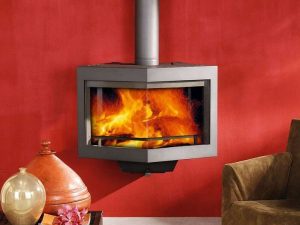99% of problems with wood stoves are caused by the wood used, or by the chimney. The problem is hardly ever with the stove, which is ultimately a very simple thing that needs dry wood to burn, and a good chimney to suck on it. (NB: chimneys don’t need bends, although some people think they do – straight and vertical is best).
An existing but unused chimney will probably be a brick stack, and so you will probably need to line and insulate it (this isn’t a building regs requirement, however). Brick chimneys are fine with an open fire, because most of the heat goes straight up the chimney (which, by the way, is the reason that open fires are not a good idea). But the smoke from a modern wood stove will be much cooler than an old stove or an open fire, because of the baffles inside it that keep the heat in the stove longer, to be radiated out into your room. Tar will condense out of cool smoke much more easily than hot smoke, especially if the chimney is uninsulated, cold brick. Tar condensing on your chimney will increase the risk of chimney fires – very dangerous.
A good installer will install your stove and flue system at the same time, and smoke test it.
Thanks to Sune Nightingale of Stoves Online.

